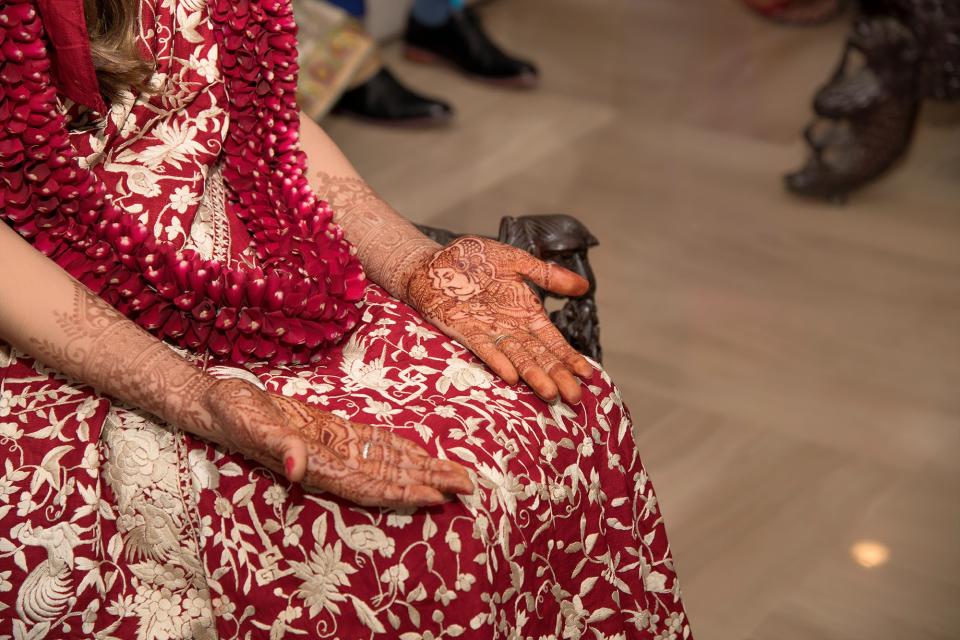Something Borrowed: How I Turned a 100-Year-Old Sari Into My Wedding Veil
A little over a year ago, my mother and I spent a quiet January morning looking at saris. As the hazy Mumbai sunshine filtered through the windows of my grandmother’s apartment, we ran our hands over the chiffons and silks. While we inspected and admired, my mother tried to recall the occasion each was last worn by her mother-in-law, who was sleeping—as she now does most of the time—in the next room. “This gray one,” she’d muse, “I think she wore that to your uncle’s wedding.” The purple, she mentioned, was for a cousin’s navjote, the rite of passage ceremony celebrated in our religious community of Indian Zoroastrians called Parsis.
My parents come to India for a few months in December and June, staying at my grandmother’s home which is also my father’s childhood home. Every winter, my brothers and I join them for a week or so, lately with partners and children in tow. Examining these heirloom fabrics has become a yearly ritual for my mother and me, a moment alone spent marveling over the handiwork, and ensuring that each garment is stored with its matching accoutrements: a choli (blouse) and petticoat. After attending more than four decades of weddings, my mother has amassed a sari collection of her own. When she is in India, she wears one every day, taking far more pleasure in her clothing than she ever does in the U.S.
This iteration of our annual inspection carried within it a specific purpose. In December 2018, I would be ceremoniously draped for my own Parsi wedding ceremony. I pawed through the fabrics, inhaling the earthy scent of mothballs and cedar. Ultimately, I chose a red gara, a heavily-embroidered silk sari most commonly worn by Parsi women. Festooned with birds and flowers sewn at least one century ago, the bold crimson material felt auspicious, heavy, decadent. One of the oldest in the collection, I knew that it must once have been wrapped ever-so-stylishly around my grandmother’s body, and likely her mother’s before her. That is the unique pleasure of inheriting saris—they are just yards of cloth, never out of style, never requiring adjustments. Even for me whose body, my grandmother still likes to point out, is far more voluptuous than hers.

Our decision made, we prepared to close the closet. But, peeking out at the bottom was an unfamiliar piece of crumpled white material smelling deeply of damp neglect. As we unfurled the fabric, we noticed an adornment of small white flowers and a magnificent geometric pattern at the end—the section known as a pallu—and shook our heads at the areas marred by holes.
As of that morning, my “official” wedding, which would take place in Cambridge, Massachusetts, where my parents live, was seven months away. I’d selected my dress some weeks earlier, a whimsical creation with a bodice, rippled skirt, and horsehair hem. I knew I wanted to wear a veil—because when else in life can you?—and was inspired by the frothy, romantic lace mantillas of Goya’s paintings. As my mother and I inspected this pale, age-worn fabric, I knew it could be transformed into the veil I desired. When I said this, we knew immediately who would create it: Ana Colbert, my high school Spanish teacher turned mother’s close friend. It felt appropriate that the person who fashioned my Goya-inspired veil should be a Spaniard herself. In addition to many other talents, she is an extraordinary seamstress and, with just a few fittings, managed to create a resplendent headcovering from a tattered cloth.

During her speech at our wedding, my mother referenced what she called “a typical Leah moment.” “Some of you might have noticed the veil she wore during the ceremony,” she said, going on to explain: “It has a marvelous history—it’s a sari that has belonged to Leah’s grandmother Naju for many years; delicate, frail beyond measure. We decided it would make the perfect complement to the rest of the wedding outfit and bring Naj who, alas, is not well enough to be with us here, into the wedding celebration.”
Coupled with my engagement ring, a cocktail ring from the 1950s belonging to my great-grandmother, I brought the legacy of these women into the newest phase of my life. On the last morning of 2018, the day after our Indian wedding, I hung up the red gara and set it aside to be cleaned. Helping me fold the fabric, my mother turned to me. “You know,” she said, “I’m pretty sure that’s the very same sari I wore to our wedding.”
Originally Appeared on Vogue

